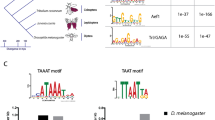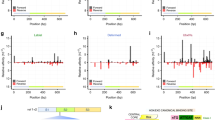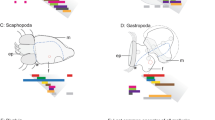Abstract
Variations in Hox protein sequences and functions have been proposed to contribute to evolutionary changes in appendage shape and number in crustaceans and insects. One model is that insect Hox proteins of the Ultrabithorax (UBX) ortholog class evolved increased abilities to repress Distal-less (Dll) transcription and appendage development in part through the loss of serine and threonine residues in casein kinase 2 (CK2) phosphorylation sites. To explore this possibility, we constructed and tested the appendage repression function of chimeric proteins with insertions of different CK2 consensus sites or phosphomimetics of CK2 sites in C-terminal regions of Drosophila melanogaster UBX. Our results indicate that CK2 sites C-terminal to the homeodomain can inhibit the appendage repression functions of UBX proteins, but only in the context of specific amino acid sequences. Our results, combined with previous findings on evolutionary changes in Hox protein, suggest how intra-protein regulatory changes can diversify Hox protein function, and thus animal morphology.






Similar content being viewed by others
References
Averof M, Akam M (1995) Hox genes and the diversification of insect and crustacean body plans. Nature 376:420–423
Bennett RL, Brown JS, Denell RE (1999) Molecular and genetic analysis of the Tribolium Ultrabithorax ortholog, Ultrathorax. Dev Genes Evol 209:608–619
Berry M, Gehring W (2000) Phosphorylation status of the SCR homeodomain determines its functional activity: essential role for protein phosphatase 2A,B¢. EMBO J 19(12):2946–2957
Bolinger RA, Boekhoff-Falk G (2005) Distal-less functions in subdividing the Drosophila thoracic limb primordium. Dev Dyn 232(3):801–816
Bourbon HM, Martin-Blanco E, Rosen D, Kornberg TB (1995) Phosphorylation of the Drosophila engrailed protein at a site outside its homeodomain enhances DNA binding. J Biol Chem 270(19):11130–11139
Brand AH, Manoukian AS, Perrimon N (1994) Ectopic expression in Drosophila. In: Goldstein LSB, Fyrberg E (eds) Methods in cell biology. Academic, New York
Capovilla M, Botas J (1998) Functional dominance among Hox genes: repression dominates activation in the regulation of Dpp. Development 125(24):4949–4957
Carroll SB, Grenier JK, Weatherbee SD (2005) From DNA to diversity, 2nd edn. Blackwell Science, London
Castelli-Gair J, Akam M (1995) How the Hox gene Ultrabithorax specifies two different segments: the significance of spatial and temporal regulation within metameres. Development 121:2973–2982
Galant R, Carroll SB (2002) Evolution of a transcriptional repression domain in an insect Hox protein. Nature 415:910–913
Gavis ER, Hogness DS (1991) Phosphorylation, expression and function of the Ultrabithorax protein family in Drosophila melanogaster. Development 112(4):1077–1093
Gay NJ, Poole SJ, Kornberg TB (1988) The Drosophila engrailed protein is phosphorylated by a serine-specific protein kinase. Nucleic Acids Res 16(14A):6637–6647
Ghose R, Malik M, Huber PW (2004) Restricted specificity of Xenopus TFIIIA for transcription of somatic 5S rRNA genes. Mol Cell Biol 24(6):2467–2477
Gonzalez-Reyes A, Morata G (1990) The developmental effect of overexpressing a Ubx product in Drosophila embryos is dependent on its interactions with other homeotic products. Cell 61:515–522
Grenier JK, Carroll SB (2000) Functional evolution of the Ultrabithorax protein. Proc Natl Acad Sci USA 97(2):704–709
Grenier JK, Garber TL, Warren R, Whitington PM, Carroll S (1997) Evolution of the entire arthropod Hox gene set predated the origin and radiation of the onychophoran/arthropod clade. Curr Biol 7:547–553
Hittinger CT, Stern DL, Carroll SB (2005) Pleiotropic functions of a conserved insect-specific Hox peptide motif. Development 132(23):5261–5270
Hsia CC, McGinnis W (2003) Evolution of transcription factor function. Curr Opin Genet Dev 13(2):199–206
Hughes CL, Kaufman TC (2002) Hox genes and the evolution of the arthropod body plan. Evol Dev 4(6):459–499
Jaffe L, Ryoo H, Mann RS (1997) A role for phosphorylation by casein kinase II in modulating Antennapedia activity in Drosophila. Genes Dev 11:1327–1340
Jeong S, Rokas A, Carroll SB (2006) Regulation of body pigmentation by the abdominal-B hox protein and its gain and loss in Drosophila evolution. Cell 125(7):1387–99
Kosman D, Mizutani CM, Lemons D, Cox WG, McGinnis W, Bier E (2004) Multiplex detection of RNA expression in Drosophila embryos. Science 305(5685):846
Larroux C, Fahey B, Degnan SM, Adamski M, Rokhsar DS, Degnan BM (2007) The NK homeobox gene cluster predates the origin of Hox genes. Curr Biol 17(8):706–710
Lemons D, McGinnis W (2006) Genomic evolution of Hox gene clusters. Science 313(5795):1918–1922
Lewis DL, DeCamillis M, Bennett RL (2000) Distinct roles of the homeotic genes Ubx and abd-A in beetle embryonic abdominal appendage development. Proc Natl Acad Sci U S A 97(9):4504–4509
Lohr U, Pick L (2005) Cofactor-interaction motifs and the cooption of a homeotic Hox protein into the segmentation pathway of Drosophila melanogaster. Curr Biol 15(7):643–649
Lohr U, Yussa M, Pick L (2001) Drosophila fushi tarazu: a gene on the border of homeotic function. Curr Biol 11(18):1403–1412
Mann RS, Carroll SB (2002) Molecular mechanisms of selector gene function and evolution. Curr Opin Genet Dev 12(5):592–600
McGinnis W, Krumlauf R (1992) Homeobox genes and axial patterning. Cell 68:283–302
Meggio F, Pinna LA (2003) One-thousand-and-one substrates of protein kinase CK2. FASEB J 17(3):349–368
Palopoli MF, Patel NH (1998) Evolution of the interaction between Hox genes and a downstream target. Curr Biol 8(10):587–590
Panganiban G, Sebring A, Nagy L, Carroll S (1995) The development of crustacean limbs and the evolution of arthropods. Science (Wash D C) 270(5240):1363–1366
Papillon D, Telford MJ (2007) Evolution of Hox3 and ftz in arthropods: insights from the crustacean Daphnia pulex. Dev Genes Evol 217(4):315–22
Pearson JC, Lemons D, McGinnis W (2005) Modulating Hox gene functions during animal body patterning. Nat Rev Genet 6(12):893–904
Pokholok DK, Zeitlinger J, Hannett NM, Reynolds DB, Young RA (2006) Activated signal transduction kinases frequently occupy target genes. Science 313(5786):533–536
Poole A, Poore T, Bandhakavi S, McCann RO, Hanna DE, Glover CV (2005) A global view of CK2 function and regulation. Mol Cell Biochem 274(1–2):163–170
Ronshaugen M, McGinnis N, McGinnis W (2002) Hox protein mutation and macroevolution of the insect body plan. Nature 415:914–917
Schwartz CJE, Sampson HM, Hlousek D, Percival-Smith A, Copeland JWR, Simmonds AJ, Krause HM (2001) FTZ-factor1 and Fushi tarazu interact via conserved nuclear receptor and coactivator motifs. EMBO 20:510–519
Shiga Y, Yasumoto R, Yamagata H, Hayashi S (2002) Evolving role of Antennapedia protein in arthropod limb patterning. Development 129(15):3555–3561
Stuart JJ, Brown SJ, Beeman RW, Denell RE (1991) A deficiency of the homeotic complex of the beetle Tribolium. Nature 350(6313):72–74
Stultz BG, Jackson DG, Mortin MA, Yang X, Beachy PA, Hursh DA (2006) Transcriptional activation by extradenticle in the Drosophila visceral mesoderm. Dev Biol 290(2):482–494
Sun B, Hursh DA, Jackson D, Beachy PA (1995) Ultrabithorax protein is necessary but not sufficient for full activation of decapentaplegic expression in the visceral mesoderm. EMBO 14:520–535
Telford MJ (2000) Evidence for the derivation of the Drosophila fushi tarazu gene from a Hox gene orthologous to lophotrochozoan Lox5. Curr Biol 10(6):349–352
Tour E, Hittinger CT, McGinnis W (2005) Evolutionarily conserved domains required for activation and repression functions of the Drosophila Hox protein Ultrabithorax. Development 132(23):5271–5281
Tremml G, Bienz M (1989) Homeotic gene expression in the visceral mesoderm of Drosophila embryos. EMBO J 8:2677–2685
Tsong AE, Tuch BB, Li H, Johnson AD (2006) Evolution of alternative transcriptional circuits with identical logic. Nature 443(7110):415–420
Warren RW, Nagy L, Selegue J, Gates J, Carroll S (1994) Evolution of homeotic gene regulation and function in flies and butterflies. Nature 372:458–461
Yussa M, Lohr U, Su K, Pick L (2001) The nuclear receptor Ftz-F1 and homeodomain protein Ftz interact through evolutionarily conserved protein domains. Mech Dev 107(1–2):39–53
Acknowledgments
We are grateful to Rob White for providing antiserum directed against UBX protein, to Dave Kosman for the help with confocal microscopy and staining, and to the members of the McGinnis lab for intellectual and practical assistance in many areas.
Author information
Authors and Affiliations
Corresponding author
Additional information
Communicated by C. Desplan
Rights and permissions
About this article
Cite this article
Taghli-Lamallem, O., Hsia, C., Ronshaugen, M. et al. Context-dependent regulation of Hox protein functions by CK2 phosphorylation sites. Dev Genes Evol 218, 321–332 (2008). https://doi.org/10.1007/s00427-008-0224-1
Received:
Accepted:
Published:
Issue Date:
DOI: https://doi.org/10.1007/s00427-008-0224-1




